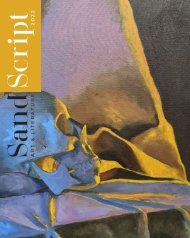SandScript 2023 [Digital Exclusive]
You also want an ePaper? Increase the reach of your titles
YUMPU automatically turns print PDFs into web optimized ePapers that Google loves.
Academic Essay<br />
THE AID OF MUSIC IN THE FOREIGN LANGUAGE<br />
CLASSROOM<br />
Marriah Nissen<br />
Students learn language through many different tools, and while some stick, others<br />
never seem to aid in the learning process. One tool that allows for the knowledge to become<br />
more thoroughly processed in a student’s mind is the use of music. In many ways, teaching<br />
music is similar to teaching a foreign language through the way it engages the student’s mind<br />
in both learning ability and style. Foreign languages and music deal with sound and how it<br />
should properly be produced. In this paper, I will show that music is a useful tool that allows for<br />
a student to not only process the information, but also increases the ability for this information<br />
to remain in the student’s memory.<br />
As I stated above, teaching music and a foreign language are very similar. Gerald S.<br />
Giauque, in his essay “Foreign Language Acquisition and the Study of Music,” puts it simply,<br />
“That since both music and foreign languages deal with sounds, making the transfer from<br />
one discipline to the other is fairly easy” (Giauque 2). He is right. Music and language do<br />
share several features. First, we see that both stem from the processing of sounds. Next,<br />
we see that both are used by their authors/speakers to convey a message whose effect is<br />
mainly emotional. They also both have intrinsic features in common, such as pitch, volume,<br />
prominence, stress, tone, rhythm, and pauses. Another shared feature is that we learn both of<br />
them through continued exposure. Just like music, a foreign language is almost impossible to<br />
learn without having a high level of contact with it in the classroom.<br />
Giauque has a very simple way of comparing how both are approached similarly. Students<br />
come to class and they go through what he calls the “warming-up” period. In a music<br />
classroom, the warming up period requires getting out the instruments and tuning them so<br />
they are ready to play correctly when the time comes. This idea is very similar in a foreign<br />
language environment. The students come in and right away the instructor starts off with a<br />
revision or a “warm-up.” The instructor usually does not allow for a time in which the students<br />
sit around and speak in English. They become disciplined to know that, once they enter the<br />
door of the foreign language classroom, they should be ready to speak the target language.<br />
Once the students have had this revision time, they are more comfortable with continuing with<br />
the rest of the class period. “The reason for this is that the student must CONSCIOUSLY turn<br />
his mind to the foreign language and begin to concentrate on the language, if he is to acquire<br />
it and begin to think in it, if he is to become fluent” (Giauque 3). Playing music and speaking a<br />
foreign language require a conscious effort to be productive with the information the student<br />
is given. The idea is to exclude English from the classroom, so this requires an effort on the<br />
part of the student along with concentration and will. With music, the student must be ready<br />
to play, and this means leaving everything that is disruptive to the learning process outside<br />
the classroom and focusing in on the instruments and sheet music before them. The student<br />
must decide with conviction that he will communicate through the target language, even if the<br />
language is music.<br />
199


![SandScript 2023 [Digital Exclusive]](https://img.yumpu.com/68282062/202/500x640/sandscript-2023-digital-exclusive.jpg)



